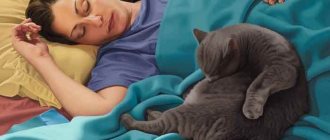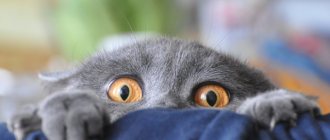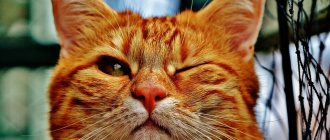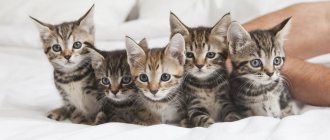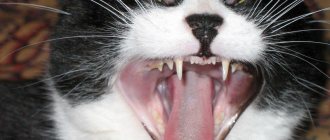Causes
The most common cause of loss of coordination of movements is infectious diseases affecting the nervous system and brain. These, in most cases, include panleukopenia.
Cerebellar - often the cause of ataxia is aplasia of brain structures. This disease is congenital in nature and can arise both from a hereditary genetic predisposition and from developmental disorders in the prenatal period. Typically, sick kittens are born when the mother has panleukopenia. Also, the cause of damage to the cerebellum and the subsequent development of ataxia can be traumatic brain injury, inflammatory processes and cerebral edema.
With vestibular ataxia, there are two options for the development of the disease:
- The structure of the inner ear - the cause is its damage due to otitis media, neuritis of the craniofacial nerves, idiopathic vestibular syndrome and tumors.
- The medulla oblongata and brain stem are tumors.
Possible causes of disorders in spinal ataxia are intervertebral hernias, inflammatory diseases and spinal cord trauma.
Old cat syndrome
How old is your pet? Ten? More? Then this is definitely the place for you! Because after 8-10 years, various age-related changes begin to occur in the cat’s body, which you need to be aware of and take into account. May your four-legged pet live happily ever after!
By the way, previously the age limit for our pets was much lower - 12-year-old cats were considered long-livers. It was man who raised the quality of life, and with it its duration, by one and a half to two times.
And now it is easy to meet cats that have reached 16-19 years of age, or even more. For example, in our clinic we see two cats, each 21 years old, and the most significant thing that worries them is their teeth, or rather, tartar, which is removed from them from time to time.
So, among pets, the number of “elderly” pets (approximately 30%) who need optimal care is increasing.
It is a fact that with the increase in the number of years lived, everything changes (and not only for cats :-)). Age-related changes affect all body functions. For now, we will consider only behavioral ones.
The causes of behavioral changes can be a number of diseases (including systemic ones) acquired by the animal over the years of its life, brain pathologies, as well as CDS - cognitive dysfunction syndrome. First, let's look at medical ailments, and then move on to the most interesting part.
Osteoarthritis (joint disease) can occur in 65% of cats over 12 years of age (the elbow and hip joints are most commonly affected, and the knee and shoulder are less common). Joint pain leads to decreased mobility and the appearance of aggressiveness when communicating with people and other animals.
Systemic hypertension (high blood pressure) often causes a pet to scream at night, become disoriented in space, lose consciousness, senseless circular movements and
We recommend reading: Condition of Dogs After Tartar Cleaning
Source
Symptoms
Despite the similar symptoms of all types of ataxia, there are different signs that depend on the cause of the disease.
All types of violations are characterized by:
- Staggering "drunk" gait. The cat walks with its hind legs widely spaced, raising them high.
- Changes in head position - usually it is tilted to the side or down.
When the spinal cord is damaged, pain occurs when walking, and the animal tries to move less. Very often there is no loss of coordination of the head.
Cerebellar ataxia is characterized by the presence of tremor during movement - when walking or running, the animal’s body trembles slightly, often only the back part. There may also be nystagmus, which is rapid eye movements that are independent of where the cat is looking or what the cat is observing.
If there is damage to the vestibular apparatus, then nystagmus is also observed, severe pain in the head is possible (the cat meows, sits in the corner with its forehead pressed to the wall).
Why is the cat walking in circles?
Here is a man sitting, and my black cat is walking around him in circles, why?
He feels strength and power in him, but at the same time he knows his weak points and wants to improve his energy in his own way, removing the accumulated negativity.
The circle is a solar symbol, which is determined not only by its shape, but also by the circular nature of the daily and annual movement of the sun.
The circle symbolizes infinity, completeness and perfection. The circle has many meanings, and all nations used the symbol of the “circle” in religious rituals.
The cat is “Satan’s assistant” and contains “darkness, lust, deceit, betrayal and laziness.” This has long been considered in Christianity, completely undeservedly.
Cat Bayun is not just a smart cat, but also a “talker” with a magical voice. He speaks and lulls approaching travelers to sleep with his tales. Those who are not strong enough to resist his magic and who are not prepared to fight him are mercilessly killed by the sorcerer cat.
We recommend reading: Cat With an Orange Belly
The cat walks in circles in one direction.
This is almost exactly what they said at the veterinary clinic. But they just said that it had nothing to do with the abscess. The cat's reactions are all positive (light (pupils), tingling (spine). They prescribed a course of injections until Thursday:
Last night I started walking around the apartment restlessly, and then started walking in circles - to the left. An hour later they gave Kot-Bayun (nothing else was at hand) and he calmed down. Today the circle was repeated again (given Kot-Bayun)
My cat walks in circles.
Author, you still take the poor living creature to the veterinarian, she is suffering while you are doubting the diagnosis. Indeed, such behavior is a sign of worms, severe anxiety, and a repeated route is a cycle. If the veterinarian says that the animal is healthy, or after a course of anti-worm tablets she does not stop, then we can already
Source
Diagnostics
One of the first diagnostic methods will be a thorough history taking. It is important to know about the cat's previous injuries, infectious diseases and nutrition. If possible, family heredity and the peculiarities of pregnancy in the mother cat are determined.
The animal is examined by a neurologist to assess the functionality and disorders of the nervous system.
Determine serological reactions to dangerous feline viruses - immunodeficiency virus, panleukopenia and leukemia.
If the clinic has the opportunity, then they conduct an MRI diagnosis of the brain; tumors, aplasia of areas, hemorrhages and edema are clearly visible on it. It is also possible to use ultrasound and radiography.
The ear is examined using an otoscope.
If there is a suspicion of infection of the brain or spinal cord, cerebrospinal fluid is taken to analyze leukocytes and protein, and a bacteriological examination is also carried out.
why do cats walk in circles
ZooForum: The cat is walking in a circle. Stroke? — ZooForum
(others can give advice in a PM, indicating that the advice is not given by a veterinarian. But the forum is not responsible for THESE advice.)
The cat walks in circles in one direction.
This is almost exactly what they said at the veterinary clinic. But they just said that it had nothing to do with the abscess. The cat's reactions are all positive (light (pupils), tingling (spine). They prescribed a course of injections until Thursday:
My cat walks in circles.
Author, you still take the poor living creature to the veterinarian, she is suffering while you are doubting the diagnosis. Indeed, such behavior is a sign of worms, severe anxiety, and a repeated route is a cycle. If the veterinarian says that the animal is healthy, or after a course of anti-worm tablets she does not stop, then one can already suspect mysticism.
Or rather, he runs at night. counterclockwise. Passes under the bed, and in a circle along the wall, then again under the bed, and so on a hundred times in a row. It’s getting scary(((who has had this? What does she want? Why is she doing this?
This can be fully explained: when a cat needs to perform a specific action, it can calmly rely not on vision, but on other senses; cats can run towards a sound in absolute darkness, avoid obstacles relying on touch (whiskers), or navigate by smell etc. and when a cat does not have a certain action, it begins to toil and just walks around to explore the space, and a defect appears.
This is partly an assumption and it is possible that your cat simply has a mental disorder, BUT, I and my friends have had many cats, none of them have observed such a habit, although there are plenty of oddities - for example, the cat that now lives with me is rather closer in behavior to a dog than to a cat - she is completely
Source
Treatment
The tactics of the prescribed treatment depend on the causes of ataxia. B vitamins, especially B12, are mandatory. Gamavit is used to strengthen the immune system and the body as a whole.
The medicinal substance Proserin also penetrates well through the blood-brain barrier and helps restore nerve conduction.
With cerebellar ataxia, treatment of the disease is extremely difficult. After all, the basis of the disease is degenerative changes in the brain. Cerebrolysin (Cerebrolysate) is used to improve cerebral circulation and tissue regeneration.
To improve the functioning of brain tissue, glycine is used 0.25 t once a day for 2 weeks, piracetam 0.3 ml IV and caviton 0.25 t 3 times a day for a week.
In case of spinal cord damage, surgical treatment is prescribed in most cases. Physiotherapy is also used - UHF, UMI (pulse therapy), massage.
If there is an infection, then antibiotics are used - ampicillin, vancomycin. Often the cat will require anti-toxic therapy. To do this, use a drip infusion of saline solutions - saline solution with glucose. Glucocorticosteroids – prednisolone – are also administered.
If there is cerebral edema or hydrocephalus, diuretics are prescribed - furosemide, veroshpiron.
Severe tremor can be relieved by using diazepam, but in this case it is necessary to carefully monitor the condition of the liver and prescribe minimal doses of the drug, as it is toxic to the liver.
Owners of kittens with cerebellar ataxia should remember that after the animal reaches the age of 1 year, its condition stabilizes, and the pet can continue to live happily. Such pets have extraordinary intelligence and kindness, but they require the safest possible life and good care, and, of course, love and affection.
Now in the United States there is even a special queue where residents sign up to shelter animals with this diagnosis.
Preventative measures for frequent urination
Preventive measures for frequent urination are individual for each case. The general criterion is strict control of food and drink. The pet's menu should consist of high-quality fresh products.
Vitamins are our everything
Avoid dangerous and stressful situations for the cat. Prevent the risk of infections: limit contact with other animals, ensure favorable sanitary and hygienic conditions. Provide animals with diabetes mellitus with a strict feeding regimen, every hour.
We suggest you read: Why do rabbits sneeze?
Cats prone to cystitis must be given a warm place to rest: no drafts, soft bedding. Mandatory vaccination of animals according to a clearly specified schedule, mandatory timely medical examination.
Prevention
- Mandatory vaccination against panleukopenia, rhinovirus and feline leukemia virus.
- To avoid injury to the animal as much as possible, it is advisable to limit free access to the street.
- Careful protection of the health of a pregnant cat, a ban on its communication with other animals.
- When planning a mating, be sure to check the cat for panleukopenia.
- Timely treatment of otitis and inflammatory ear diseases.
- Urgent hospitalization of a cat if a traumatic brain injury is suspected.
- Check with the breeder about genetic diseases in relatives and about the mother’s pregnancy history.
Infections of the genitourinary system
The genitourinary system of a cat.
The situation is the same with infections of the genitourinary system. It is common for a cat to periodically go to the litter box “in a small way,” but if such a pattern is observed very often, you should pay special attention to this.
This means something is wrong.
If a cat has free access to water, then she walks up to three times a day.
The cat peed many times during the day, which can be seen from the litter box. In the morning it was clean and the filling was fresh. Frequent urination in a cat is a reason to sound the alarm.
If the pet runs to the tray more often than these indicators, remains on the tray longer than usual, pees with effort, perhaps meowing plaintively, and the sound of the stream cannot be heard - this is a reason to suspect illness and consult a doctor.
We suggest you read: Why cats and cats trample a person and a blanket with their front paws and purr

